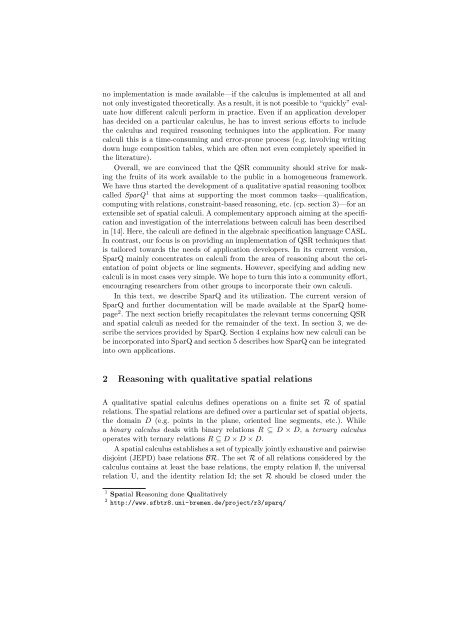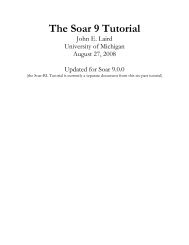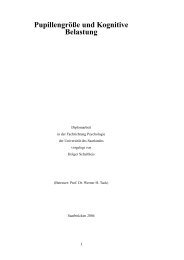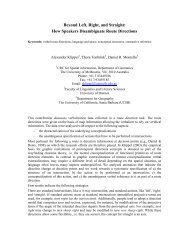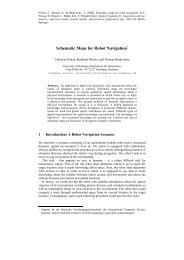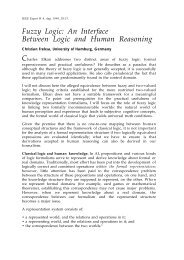SparQ: A Toolbox for Qualitative Spatial Representation and ...
SparQ: A Toolbox for Qualitative Spatial Representation and ...
SparQ: A Toolbox for Qualitative Spatial Representation and ...
You also want an ePaper? Increase the reach of your titles
YUMPU automatically turns print PDFs into web optimized ePapers that Google loves.
no implementation is made available—if the calculus is implemented at all <strong>and</strong><br />
not only investigated theoretically. As a result, it is not possible to “quickly” evaluate<br />
how different calculi per<strong>for</strong>m in practice. Even if an application developer<br />
has decided on a particular calculus, he has to invest serious ef<strong>for</strong>ts to include<br />
the calculus <strong>and</strong> required reasoning techniques into the application. For many<br />
calculi this is a time-consuming <strong>and</strong> error-prone process (e.g. involving writing<br />
down huge composition tables, which are often not even completely specified in<br />
the literature).<br />
Overall, we are convinced that the QSR community should strive <strong>for</strong> making<br />
the fruits of its work available to the public in a homogeneous framework.<br />
We have thus started the development of a qualitative spatial reasoning toolbox<br />
called <strong>SparQ</strong> 1 that aims at supporting the most common tasks—qualification,<br />
computing with relations, constraint-based reasoning, etc. (cp. section 3)—<strong>for</strong> an<br />
extensible set of spatial calculi. A complementary approach aiming at the specification<br />
<strong>and</strong> investigation of the interrelations between calculi has been described<br />
in [14]. Here, the calculi are defined in the algebraic specification language CASL.<br />
In contrast, our focus is on providing an implementation of QSR techniques that<br />
is tailored towards the needs of application developers. In its current version,<br />
<strong>SparQ</strong> mainly concentrates on calculi from the area of reasoning about the orientation<br />
of point objects or line segments. However, specifying <strong>and</strong> adding new<br />
calculi is in most cases very simple. We hope to turn this into a community ef<strong>for</strong>t,<br />
encouraging researchers from other groups to incorporate their own calculi.<br />
In this text, we describe <strong>SparQ</strong> <strong>and</strong> its utilization. The current version of<br />
<strong>SparQ</strong> <strong>and</strong> further documentation will be made available at the <strong>SparQ</strong> homepage<br />
2 . The next section briefly recapitulates the relevant terms concerning QSR<br />
<strong>and</strong> spatial calculi as needed <strong>for</strong> the remainder of the text. In section 3, we describe<br />
the services provided by <strong>SparQ</strong>. Section 4 explains how new calculi can be<br />
be incorporated into <strong>SparQ</strong> <strong>and</strong> section 5 describes how <strong>SparQ</strong> can be integrated<br />
into own applications.<br />
2 Reasoning with qualitative spatial relations<br />
A qualitative spatial calculus defines operations on a finite set R of spatial<br />
relations. The spatial relations are defined over a particular set of spatial objects,<br />
the domain D (e.g. points in the plane, oriented line segments, etc.). While<br />
a binary calculus deals with binary relations R ⊆ D × D, a ternary calculus<br />
operates with ternary relations R ⊆ D × D × D.<br />
A spatial calculus establishes a set of typically jointly exhaustive <strong>and</strong> pairwise<br />
disjoint (JEPD) base relations BR. The set R of all relations considered by the<br />
calculus contains at least the base relations, the empty relation ∅, the universal<br />
relation U, <strong>and</strong> the identity relation Id; the set R should be closed under the<br />
1 <strong>Spatial</strong> Reasoning done <strong>Qualitative</strong>ly<br />
2 http://www.sfbtr8.uni-bremen.de/project/r3/sparq/


